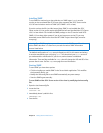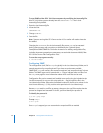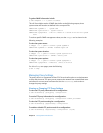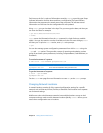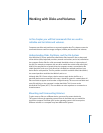
76 Chapter 6 Setting Network Preferences
To gather SNMP information in bulk:
$ sudo snmpwalk -v 1 -c public
localhost
This will list multiple entries of SNMP data similar to the following output, where
system name and location are defined in the snmp.conf file.
SNMPv2-MIB::sysName.0 - system name
SNMPv2-MIB::sysLocation.0 - system location
SNMPv2-MIB::sysUpTime.0 - time in 1/100ths of a second since the last system
start
To retrieve specific SNMP management values, use the snmpget tool as shown in the
following examples.
To view the system name:
$ snmpget -v 1 -c public localhost system.sysName.0
SNMPv2-MIB::sysName.0 = STRING: xlabxs06.apple.com
To view the system location:
$ snmpget -v 1 -c public localhost system.sysLocation.0
SNMPv2-MIB::sysLocation.0 = STRING: "server_room"
To view the system uptime:
$ snmpget -v 1 -c public localhost system.sysUptime.0
SNMPv2-MIB::sysUpTime.0 = Timeticks: (72239) 0:12:02.39
For a list of snmp man pages, enter the following:
$ man -k snmp
Managing Proxy Settings
The proxy server is a component of Mac OS X Server that functions as a relay between
a client and the server. This proxy server protects the network from unauthorized users
and allows for a more secure environment. Use the networksetup tool to view or
change the proxy settings.
Viewing or Changing FTP Proxy Settings
To view the FTP proxy information for a configuration:
$ sudo networksetup -getftpproxy "
configuration
"
To set the FTP proxy information for a configuration:
$ sudo networksetup -setftpproxy "
configuration
"
domain
portnumber
To view the FTP passive setting for a configuration:
$ sudo networksetup -getpassiveftp "
configuration
"
To enable or disable FTP passive mode for a configuration:
$ sudo networksetup -setpassiveftp "
configuration
" (on|off)








